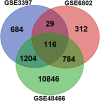Identification of key genes in human airway epithelial cells in response to respiratory pathogens using microarray analysis
- PMID: 29884128
- PMCID: PMC5994059
- DOI: 10.1186/s12866-018-1187-7
Identification of key genes in human airway epithelial cells in response to respiratory pathogens using microarray analysis
Abstract
Background: Airway epithelium is the primary target for pathogens. It functions not only as a mechanical barrier, but also as an important sentinel of the innate immune system. However, the interactions and processes between host airway epithelium and pathogens are not fully understood.
Results: In this study, we identified responses of the human airway epithelium cells to respiratory pathogen infection. We retrieved three mRNA expression microarray datasets from the Gene Expression Omnibus database, and identified 116 differentially expressed genes common to all three datasets. Gene functional annotations were performed using Gene Ontology and pathway analyses. Using protein-protein interaction network analysis and text mining, we identified a subset of genes functioned as a group and associated with infection, inflammation, tissue adhesion, and receptor internalization in infected epithelial cells. These genes were further identified in BESE-2B cells in response to Talaromyces marneffei by Real-Time quantitative PCR (qRT-PCR). In addition, we performed an in silico prediction of microRNA-target interactions and examined our findings.
Conclusions: Using bioinformatics analysis, we identified several genes that may serve as biomarkers for the diagnosis or the surveillance of early respiratory tract infection, and identified additional genes and miRNAs that warrant further fundamental experimental research.
Keywords: Bioinformatics analysis; Biomarker; Human airway epithelial cell; Microarray analysis; Respiratory pathogen.
Conflict of interest statement
Ethics approval and consent to participate
Competing interests
The authors declare that they have no competing interests.
Publisher’s Note
Springer Nature remains neutral with regard to jurisdictional claims in published maps and institutional affiliations.
Figures




Similar articles
-
Expression profile of lncRNA in human bronchial epithelial cells response to Talaromyces marneffei infection: A microarray analysis.Microb Pathog. 2017 Mar;104:155-160. doi: 10.1016/j.micpath.2017.01.025. Epub 2017 Jan 14. Microb Pathog. 2017. PMID: 28093235
-
Profiling of novel microRNAs elicited by EV71 and CA16 infection in human bronchial epithelial cells using high-throughput sequencing.Virus Res. 2018 Mar 2;247:111-119. doi: 10.1016/j.virusres.2018.02.008. Epub 2018 Feb 13. Virus Res. 2018. PMID: 29447975
-
Comparison analysis of microRNAs in response to EV71 and CA16 infection in human bronchial epithelial cells by high-throughput sequencing to reveal differential infective mechanisms.Virus Res. 2017 Jan 15;228:90-101. doi: 10.1016/j.virusres.2016.11.024. Epub 2016 Nov 24. Virus Res. 2017. PMID: 27890633
-
Respiratory syncytial virus infection of airway cells: Role of microRNAs.Pediatr Pulmonol. 2015 Jul;50(7):727-32. doi: 10.1002/ppul.23193. Epub 2015 Apr 2. Pediatr Pulmonol. 2015. PMID: 25847505 Review.
-
Lung epithelium as a sentinel and effector system in pneumonia--molecular mechanisms of pathogen recognition and signal transduction.Respir Res. 2006 Jul 8;7(1):97. doi: 10.1186/1465-9921-7-97. Respir Res. 2006. PMID: 16827942 Free PMC article. Review.
Cited by
-
Comparative Analysis of Gene Expression Patterns for Oral Epithelial Cell Functions in Periodontitis.Front Oral Health. 2022 May 23;3:863231. doi: 10.3389/froh.2022.863231. eCollection 2022. Front Oral Health. 2022. PMID: 35677025 Free PMC article.
-
Sixty Years from Segretain's Description: What Have We Learned and Should Learn About the Basic Mycology of Talaromyces marneffei?Mycopathologia. 2019 Dec;184(6):721-729. doi: 10.1007/s11046-019-00395-y. Mycopathologia. 2019. PMID: 31599369
-
PHILM2Web: A high-throughput database of macromolecular host-pathogen interactions on the Web.Database (Oxford). 2022 Jun 30;2022:baac042. doi: 10.1093/database/baac042. Database (Oxford). 2022. PMID: 35776535 Free PMC article.
-
Effect of sub-chronic exposure to cigarette smoke, electronic cigarette and waterpipe on human lung epithelial barrier function.BMC Pulm Med. 2020 Aug 12;20(1):216. doi: 10.1186/s12890-020-01255-y. BMC Pulm Med. 2020. PMID: 32787821 Free PMC article.
-
Serum Exosomal microRNA Profiling in AIDS Complicated with Talaromyces marneffei Infection.Infect Drug Resist. 2021 Nov 25;14:4931-4948. doi: 10.2147/IDR.S338321. eCollection 2021. Infect Drug Resist. 2021. PMID: 34858034 Free PMC article.
References
-
- Pillay-van Wyk V, Msemburi W, Laubscher R, Dorrington RE, Groenewald P, Glass T, Nojilana B, Joubert JD, Matzopoulos R, Prinsloo M, et al. Mortality trends and differentials in South Africa from 1997 to 2012: second National Burden of disease study. Lancet Glob Health. 2016;4(9):e642–e653. doi: 10.1016/S2214-109X(16)30113-9. - DOI - PubMed
-
- Disease GBD, Injury I, Prevalence C Global, regional, and national incidence, prevalence, and years lived with disability for 310 diseases and injuries, 1990-2015: a systematic analysis for the global burden of disease study 2015. Lancet (London, England) 2016;388(10053):1545–1602. doi: 10.1016/S0140-6736(16)31678-6. - DOI - PMC - PubMed
-
- Villenave R, Broadbent L, Douglas I, Lyons JD, Coyle PV, Teng MN, Tripp RA, Heaney LG, Shields MD, Power UF. Induction and antagonism of antiviral responses in respiratory syncytial virus-infected pediatric airway epithelium. J Virol. 2015;89(24):12309–12318. doi: 10.1128/JVI.02119-15. - DOI - PMC - PubMed
MeSH terms
Substances
LinkOut - more resources
Full Text Sources
Other Literature Sources

